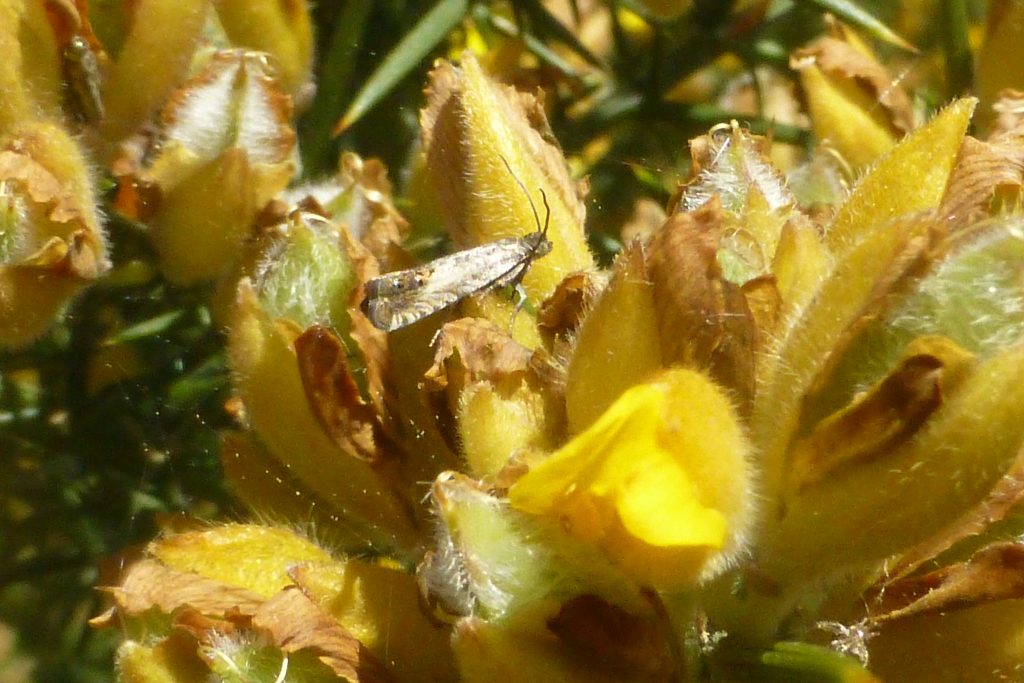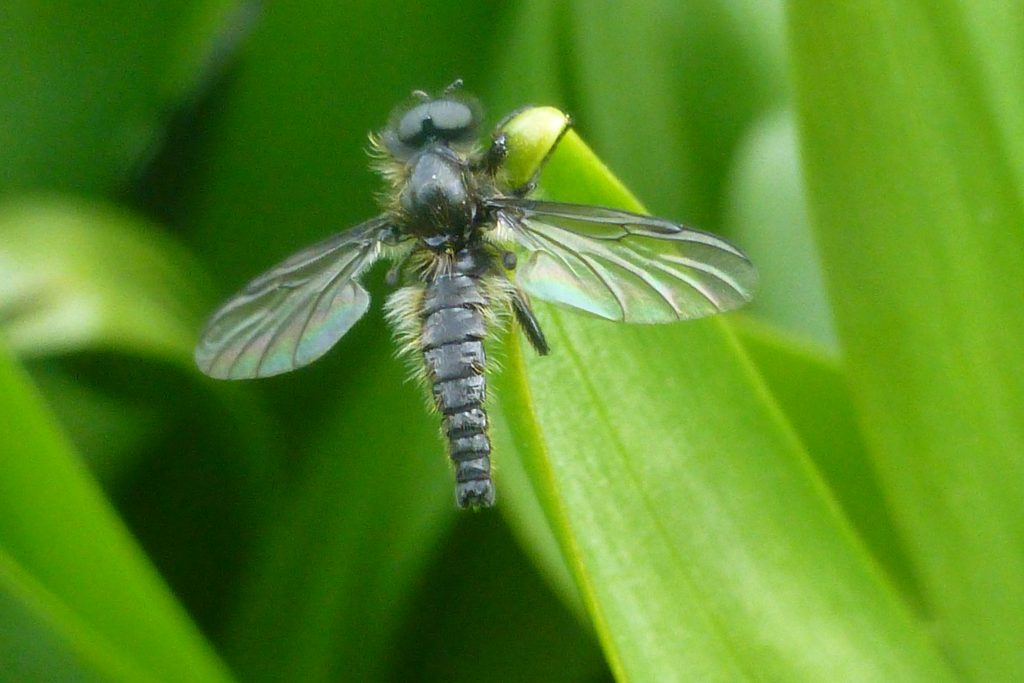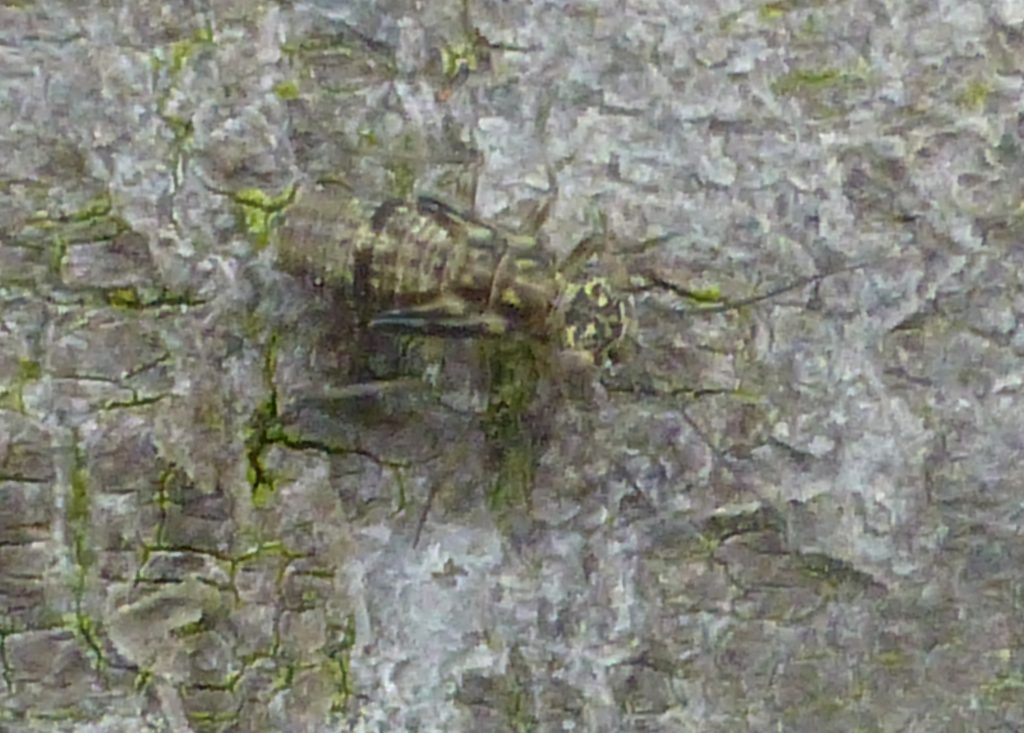May 2016 for the most part continued April’s rather chilly but dry theme. In the last few days of the month however, it seemed like summer began, for after a very damp and dreich start to the late May holiday weekend, the rest of it was mostly sunny and warm. Eleven species were added to the Garden’s list during the month, taking it from 803 to 814. One or two additional species remain unidentified that probably also represent new records.
Mammals On three days towards the end of the month (20th-22nd), an AnaBat bat detector was used to record the various species of bats visiting the Pond. No fewer than five species were recorded on the three nights; three of them (all on 20th) were new Garden records although one could not be identified to species. The new records were Brown Long-eared Bat, Noctule Bat and one of the three species of the genus Myotis recorded in Scotland, i.e. Daubenton’s Bat, Natterer’s Bat or Whiskered Bat, none of which have been recorded previously in the Garden. A full account of this bat recording effort can be found elsewhere on Botanics Stories at http://stories.rbge.org.uk/archives/20583 .
Birds May was another good month for birds at the Botanics, with forty species being recorded. The most notable were a Cuckoo heard by several staff members on 5th – it stayed for the whole day, with the first record being at around 7.45 a.m. and the last at about 6.15 p.m. A Sedge Warbler was also singing by the Pond on 5th. Other migrants included two records of Swallow (3rd and 10th), one of Garden Warbler (13th) and one of Swift (14th). Chiffchaffs sang throughout the month while, unusually, Willow Warblers were also heard in two different parts of the Garden on eight dates throughout May, suggesting that one or more males may be holding territories. Normally in the Garden, Chiffchaffs hold territories, as do Blackcaps, but Willow Warblers tend to just stop briefly for a day or two before moving on to somewhere else. However this year has been different. Meanwhile, Buzzards were seen on 4th and 5th. A Great Spotted Woodpecker pair raised young, and there were seven Mallard ducklings on the Pond. The complete list of 41 species recorded during April was: Blackbird, Blackcap, Blue Tit, Bullfinch, Buzzard, Carrion Crow, Chaffinch, Chiffchaff, Coal Tit, Cuckoo, Dunnock, Feral Pigeon, Garden Warbler, Goldcrest, Goldfinch, Great Spotted Woodpecker, Great Tit, Green Woodpecker, Greenfinch, Grey Heron, Herring Gull, Jackdaw, Lesser Black-backed Gull, Long-tailed Tit, Magpie, Mallard, Moorhen, Oystercatcher, Robin, Sedge Warbler, Siskin, Song Thrush, Sparrowhawk, Stock Dove, Swallow, Swift, Tawny Owl, Tree Creeper, Willow Warbler, Wood Pigeon, Wren.

Grey Gorse Piercer, Cydia succedana (C. ulicetana) on its host, gorse, 31 May 2016. New for the Garden and possibly Midlothian (v.c. 83). Photo Robert Mill.
Insects and other invertebrates: Six different butterfly species were recorded in the Garden during May. The most exciting was a Speckled Wood on both 12th and 14th, the first confirmed records for this species in the Garden although it has been on the list for a few years on the basis of a probable sighting. One, perhaps the same insect, was also seen in a neighbour’s garden on Inverleith Row. Speckled Wood has been spreading rapidly in Scotland over the last few years. The other five species seen in the Garden in May were Comma, Small Tortoiseshell, Small White, Orange Tip and Small Copper. However, unlike most previous years recently, Holly Blue was not recorded. A micromoth, the Grey Gorse Piercer, Cydia succedana (C. ulicetana), was seen on the same gorse patch where the Gorse Weevil was found last month; like that species, this moth is not only a new Garden record but not mapped for the Lothians in NBN so may well be a new Midlothian (v.c. 83) vice-county record. What with the Gorse Shield Bug, the Gorse Weevil and now this micromoth, there seems to be a mini ecosystem in this patch of gorse! Five of the six common bumblebees of gardens, as well as Honey Bee, were recorded on most days although numbers especially of Honey Bees seemed to be low. Tree Bumblebees were seen on 18th and 25th. Solitary bee records included Andrena haemorrhoa on 4th, Andrena bicolor on at least three dates, Andrena carantonica (=scotica) on 9th and 25th and Andrena flavipes on 9th; Halictus rubicundus on 11th and 23rd; and Hairy-footed Flower Bee (Anthophora plumipes; a new Garden record) on at least one day (25th). Black Ant was seen on 9th and Athalia cordata, a small orange and black sawfly, was found around its larval host (Bugle, Ajuga reptans) on 31st. Only five hoverfly species were seen in May: Marmalade Hoverfly, Syrphus torvus, Melanostoma scalare and Platycheirus albimanus (from 3rd) and forma bulborum of the Narcissus Bulb Fly, Merodon equestris. Other fly records included a moth fly previously not seen in the Garden and tentatively identified as Pericoma blandula on 26th. Bibio lanigerus was seen on 4th, 12th and 18th but its relative Bibio marci, the St Mark’s Fly, was totally absent in May 2016, unlike some years when there have been huge numbers. Two species of crane fly were seen, Limonia nubeculosa (13th, 17th) and Limonia phragmitidis (26th). Gorse Shield Bug was seen on several dates and Forest Bug on 23rd, while ‘cuckoo spit’ (the frothy home of young Common Froghopper) was first spotted on plant stems on 31st. Beetles accounted for three of the month’s new Garden records: these were Eyed Ladybird (9th), Hairy Spider Weevil (Borypeithes pellucidus) on 17th, and the leaf-miner Apteropeda orbiculata on Primula (from 10th). Three other ladybird species were seen: Seven-spot (18th and 23rd), Pine (10th) and 10-spot on 3rd and 9th, and a more fully developed Gorse Weevil on 31st. The two poplar leaf beetles Phratora laticollis and Phratora vitellinae both appeared as adults from 10th/11th and increasing numbers could be seen on poplar leaves for the rest of the month. A second species of springtail was added to the Garden’s list, Entomobrya albicincta (17th), while Mesopsocus immunis (also on 17th) was an addition to the Garden’s very short list of barkflies (Psocoptera). This is a rather under-recorded group of insects and, given the large number of trees in the Garden that they could inhabit, it is likely that a considerable number of species await discovery. The galls of four gall-forming mites became evident during May: Aceria macrorhyncha on sycamore, Eriophyes tiliae and E. leiosoma on lime, and Eriophyes laevis on alder.


